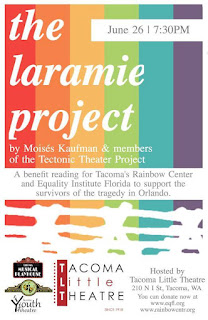Photo – Seymour
with the Doo-Wops, from left: Kristen Natalia, Brad Walker, Deshanna Brown and
Amy Shephard. Photo courtesy Harlequin Productions
Published in the Weekly Volcano, June 30. 2016
 |
| The Doo-Wops, from left: Kristen Natalia, Deshanna Brown and Amy Shephard. All photos courtesy Harlequin Productions |
I don’t want to be caught
gushing like a pre-teen meeting Justin Bieber, but I can think of nothing but
high-decibel superlatives when trying to write about the performances of
Gretchen Boyt, Rich Garrett, John Serembe and Brad Walker in Harlequin
Production’s Little Shop of Horrors.
I remember seeing it 10 years ago at Capital Playhouse, and of course I
remember the two movie versions. I remember that it was funny, but not this
funny. What I did not remember is just how much it rocks out — thanks in large
part in this production to the great Harlequin band led by Bruce Whitney and to
the fabulous Doo-Wop Girls, Deshanna Brown, Kristen Natalia and Amy Shephard,
who are so much more than backup singers. Shephard is also the choreographer,
and it is a treat to see how energetically she throws herself into her role.
She dances with infectious joy and excitement.
 |
| Seynour (Brad Walker) top, Mr. Mushnik (John Serembe) with Amy Shephard and Deshanna Brown. |
 |
| Mr. Mushnik and Semour |
 |
| Seymour with Doo-Wops |
 |
| Semour with Orin (Rich Garrett) |
 |
| Seymour and Audrey (Gretchen Boyt) |
Serembe, who may be best known
for multiple roles in The 39 Steps at
Harlequin and as the monster in Theater Artists Olympia’s The Head That Wouldn’t Die (possibly the funniest character ever to
appear on South Sound stages), plays shop owner Mr. Mushnik in a natural and
realistic manner. He is loveable in a grumpy kind of way and funny but not
outlandishly so until he teams up with the nebbish Seymour (Brad Walker) on the
song, “Mushnik and Son,” which brought tears of laughter to the eyes of the
opening night audience. Serembe’s rubber-faced expressions and his marathon of
breath-holding is a comic bit to rival the best ever seen at Harlequin (meaning
Jason Haws’s classic death scene in A
Midsummer Night’s Dream).
Right up there with him on the
top of the funny scale is Orin the motorcycle-riding dentist (Rich Garrett) who
is like a combination Elvis and Marlon Brando in The Wild One singing “Dentist” with the Doo-Wops, followed soon by
the outrageous “Now (It’s Just the Gas)” in a duet with Seymour aided by a fabulous
contraption strapped to his back that feeds gas to a fish tank globe that
encases his head (rented from the 5th Avenue Theater in Seattle). Garrett
has been absent from Olympia theater for a long time. It’s great to see him
back on stage.
Boyt’s take on the sexy, ditsy
Audrey is a spot-on riff on the classic Marilyn Monroe dumb blonde, and she has
a great voice that comes across strongly even with a comic Brooklyn accent.
As far as the plot, suffice it
to say that Seymour is in love with Audrey and he discovers a strange plant
that he names Audrey II, whose plant food is human blood. Puppeteer Maggie
Ferguson-Wagstaffe makes her come alive.
The set designed by Jeannie
Beirne is marvelous, and costume designer Darren Mills is right on the money
with his 1950s clothing.
The best laughs and the best
songs come in the first act. There is a little lull in the second act, and then
it picks up with the rousing final musical numbers with the voice of Christian Doyle as Audrey II and the Pods, and
the finale, “Little Shop of Horrors Medley” with the entire cast.
The show is popular enough that
buying tickets early should be prudent. The house was almost sold out opening
night.
Little
Shop of Horrors, Thursday through Saturday, 8p.m., Sunday 2 p.m.
through July 24, Harlequin Productions’ State Theater, 202 E. 4th
Ave., Olympia, ticket prices vary, call for details, 360-786-0151;
http://www.harlequinproductions.org/


















